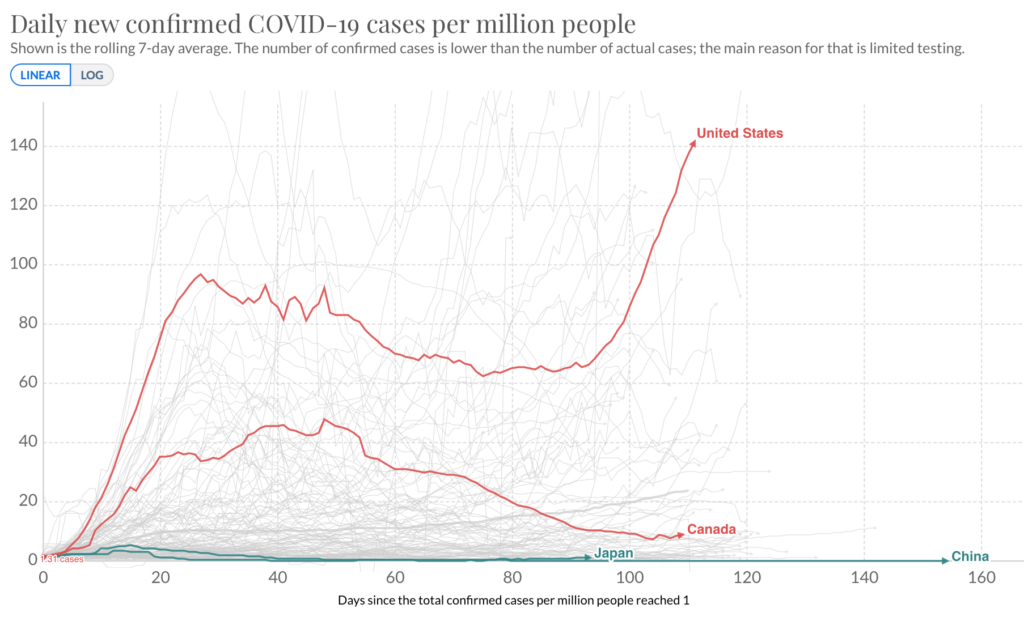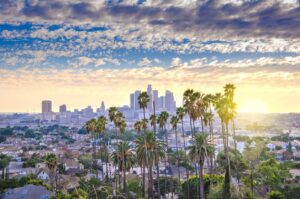Scientists are trained to be scrupulously apolitical. To reveal a political leaning is to raise the possibility of bias, the poisoned fruit of science. So, the scientific community has tended to constrain itself to comments about particular risks or the efficacy of preventive measures. Some might contradict Trump or criticize policy, but, we have avoided pointing the finger of causality directly at him. As a physician, epidemiologist, and engineer and the son of a physician scientist, this objectivity is in my bones. But, at some point, silence becomes assent. In fact, the evidence suggests that Donald Trump is directly and objectively responsible for the deaths of tens of thousands of Americans and the severe illness and chronic disability of hundreds of thousands more. Epidemiologists seek to identify risk factors for disease. It is time to evaluate our Risk Factor in Chief.
…the evidence suggests that Donald Trump is directly and objectively responsible for the deaths of tens of thousands of Americans and the severe illness and chronic disability of hundreds of thousands more…
How can we do this? One approach would be to compare the impact other governments have had on the course of the pandemic. As a crude first cut, we can compare mortality rates among countries. This is the simplest form of epidemiology and has limitations, but it provides a starting point for more detailed analysis. Let’s begin where the virus began, in China.

American exceptionalism
To date, the Chinese have reported 4,634 deaths from COVID-19. That translates to 3 deaths per million people. It is important to remember that China faced the disease under the worst possible conditions. They had no warning. Chinese doctors and scientists were fighting a disease with no way to test for it, much less treat it. When they started, it didn’t even have a name. The United States, on the other hand, had almost two months to prepare for the arrival of the virus. 132,000 deaths later, it’s clear that advance warning wasn’t enough. With 399 deaths per million people, the Americans have died at 133 times the rate seen in China. One could argue that this ratio, known as the relative risk, is not a fair comparison. There is evidence that the Chinese numbers are inaccurate. Even if they are correct, the Chinese leaders have almost total power to restrict movement and activity. Perhaps the higher rate in the US is simply the price we pay for greater freedom.
So, let’s compare ourselves to two countries near China with well-established democracies, Taiwan and Japan. A comparison with Taiwan makes the US look even worse with a relative risk of mortality of 1,330. But Taiwan, a small country on a small island and very different from the US. How about Japan with 8 deaths per million? Compared to Japan, our relative risk drops to 50, better, but hardly a ringing endorsement of US policy. Perhaps, there is just something unique about Southeast Asia. Something in their environment, diet, genes, or previous exposure that makes them less susceptible to the disease.
Let’s try something closer to home. What about Canada? Canada fared far worse than the Asian countries, but we still have 1.7 times their mortality rate. And they are far less densely populated than the US. Mexico? Essentially no difference in mortality from Canada, so the same relative risk of 1.7.
How bad are these numbers? 56,000 Americans that would still be alive, if we could have matched the public health performance of Mexico or Canada.
This is just an association. It does not prove that the policies of Trump and his administration caused those 56,000 deaths, but living in the United States during the pandemic dramatically elevated one’s risk of dying from COVID-19.
And then there’s this.

The stunning resurgence in cases in the United States seems to be unmatched in the world. For lack of a better term, call it the Trump Bump. We have yet to see a commensurate rise in death rates. Death rates trail case rates by several weeks because of the long course of the disease. Improvements in treatment and a shift towards infections in younger age groups are likely to blunt it, but some increase in deaths is inevitable.
Trump once boasted that he could kill someone on Fifth Avenue in broad daylight and get away with it. Now it appears that he’s literally doing it. Going from state to state, taking actions which have consequences as predictably deadly as the ballistics of a bullet, makes him little more than a serial killer.
Why are so many Americans Dying?
To what extent is Trump responsible for the deaths of 56,000 Americans? We can point to many times when his specific action or inaction undercut the public health response to the virus and the public receptivity to those measure. He eliminated the CDC’s sentinel outposts in China that would have provided key information as the pandemic unfolded. He insisted repeatedly that the pandemic would fade quickly when his experts were telling him the opposite. He silenced the CDC when they tried to warn the public directly. He politicized wearing a mask by refusing to wear one while insisting that everyone near him be tested daily. He instigated the firing of respiratory irritants at peaceful demonstrators for a photo op. He insisted on holding mass indoor rallies as COVID-19 was peaking in Oklahoma and Arizona despite the pleadings of health experts and clear science indicating that this created the perfect setting for super-spreading events. His team went so far as to remove social distancing signs at the Tulsa rally, seemingly out of concern that social distancing might disturb the optics. None of this explicitly quantifies Trump’s role, but all of it merits detailed analysis.
Trump once boasted that he could kill someone on Fifth Avenue in broad daylight and get away with it. Now it appears that he’s literally doing it. Going from state to state, taking actions which have consequences as predictably deadly as the ballistics of a bullet, makes him little more than a serial killer. I call on my fellow epidemiologists, as the detectives best equipped to examine the crime scene, to have the courage to evaluate the risk factor in the oval office and determine the impact of his policies on the risk of death and disease in America. Otherwise, we are the ones worrying about optics while Americans die.


Great post.
Thanks. Excellent blog, btw.